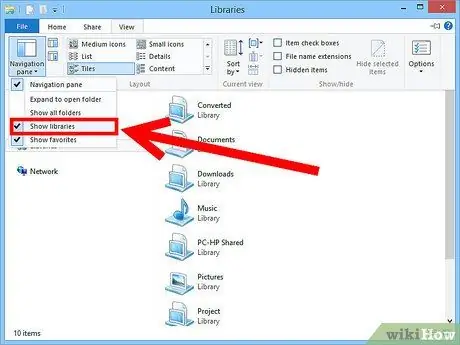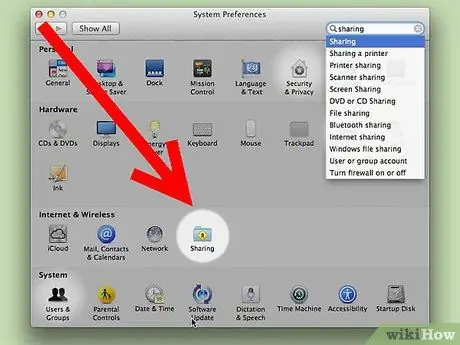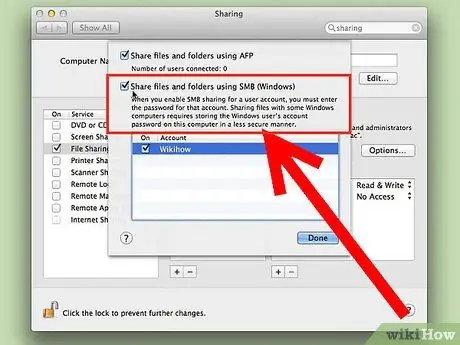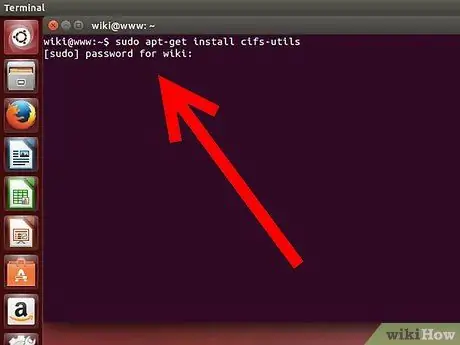- Author Jason Gerald [email protected].
- Public 2023-12-16 10:50.
- Last modified 2025-01-23 12:04.
Do you have multiple computers on your home network? You can increase network efficiency by sharing data on all computers using shared folders. This folder can be accessed by other computers on the network that have permission, and is a great way to quickly access files anywhere on the network. See Step 1 below to learn how to share folders on each operating system.
Step
Method 1 of 3: Windows
Share Specific Folders

Step 1. Make sure that File and Printer Sharing is enabled
To share a specific folder, you must enable this feature. How to activate it varies slightly depending on the version of Windows you are using. It is highly recommended not to enable shared folders when you are on a public network such as a school or coffee shop.
- Windows 8 - Right-click the Network icon in the system tray in Desktop view and select "Network and Sharing Center". Click the "Change advanced sharing settings" link. Expand the profile you want to activate (Private or Public). Enable "Network discovery" and "File and printer sharing". Click the "Save changes" button and enter the administrator password if required.
- Windows 7 - Click the Start button, type "control panel", then press Enter. Double-click the "Network and Sharing Center" icon. Click the "Change advanced sharing settings" link. Expand the profile you want to activate (Home/Work or Public). Enable "Network discovery" and "File and printer sharing". Click the "Save changes" button and enter the administrator password if required.
- Windows Vista - Click the Start menu and select Control Panel. Click Network and Internet, then select Network and Sharing Center. Expand the "Network discovery" and "File and printer sharing" entries in the "Sharing and Discovery" section. Make sure both are enabled. Click the "Save" button for each entry.
- Windows XP - Click the Start button and select Control Panel. Open Network Connections. Right click on your network connection and select Properties. Check the "File and Printer Sharing for Microsoft Networks" box.

Step 2. Find the folder to share
Once File and Printer Sharing is enabled, you can share folders on your hard drive with other people on the network. Navigate to the folder you will be sharing using Explorer. Right click on it.

Step 3. Select the "Share with" option
This will open the Sharing submenu. You can choose to share the folder with everyone in your HomeGroup or select only certain people.
When you select the HomeGroup option, you can allow other HomeGroup members to read and write to the folder, or restrict them to reading only

Step 4. Click the "Specific people" option to select the users you allow
This will open a new window with a list of users who currently have access to the folder. You can add users to this list and give them special permissions on the folder.
- To share a folder with everyone, click the drop-down menu at the top and select "Everyone". Click the Add button.
- To share with specific users, click the drop-down menu and select or type their name and then click Add.

Step 5. Set permissions for the users in the list
Look for the user in the list whose permissions you want to change. Look in the Permissions Level column, and click the arrow next to an existing permission. Select a new user from the list.
- Read - Users can view, copy, and open files from a folder, but cannot modify files or add new files.
- Read/Write - In addition to Read capabilities, users can modify files and add new files to shared folders. Files can be deleted by users who have Read/Write permissions.
- Remove - Removes permissions for this user, and removes them from the list.

Step 6. Click the Share button
Your permission settings will be saved, and the folder will be available on the network to all authorized users.
Using Public Folders

Step 1. Enable the Public folder
Public folders are folders that are always shared with anyone connected on the network. Anyone can read and write to the Public folder, and no special permissions are required. Public folders are turned off by default unless you're in the Homegroup.
- Windows 8 - Right-click the Network icon in the system tray in the Desktop view and select "Network and Sharing Center". Click the "Change advanced sharing settings" link. Expand the "All Networks" section. Look under "Public folder sharing" and enable it. Click the "Save changes" button.
- Windows 7 - Click the Start button, type "control panel", then press Enter. Double-click the "Network and Sharing Center" icon. Click the "Change advanced sharing settings" link. Expand the profile that will enable the Public folder (Home/Work or Public). Look for the "Public folder sharing" section and enable it. Click the "Save changes" button and enter the administrator password if necessary.
- Windows Vista - Click the Start menu and select Control Panel. Click Network and Internet, then select Network and Sharing Center. Expand the "Public Folder" entry under the "Sharing and Discovery" section. Activate it and click the "Save" button.

Step 2. Enable or disable Password Protected Sharing
Where you find the Public folder controls, you can find password protected sharing options. Enabling this feature means that only people who have a user account and password on the same computer can access the Public folder. If this is enabled, users on other computers will not be able to access this folder.

Step 3. Find the Public folder
Once folders are enabled, you can add files that you want to share with everyone on the network. The Public folder is part of Libraries, and accessing it is slightly different depending on your version of Windows. The Public folder is in every Libraries (Documents, Music, Pictures, and Videos).
- Windows 8 - Libraries are not displayed by default in Windows 8. To view them, click This PC to open Explorer. Click the View pane, then click the "Navigation pane" button on the far left. Click the "Show libraries" option to make the Libraries folder appear in the sidebar. Expand the library where you want to add files, and open the corresponding Public folder that appears.
- Windows 7 - Click Start and select Documents. In the left pane, expand the Libraries and Documents folder, then select Public Documents. You can also select the Public folder in other libraries.
- Windows Vista - Click Start and select Documents. In the left pane, click the Public link in the "Favorite Links" section. If you don't see it, click More and then select Public. Select the Public folder where you want to add the file.

Step 4. Add files
You can add and move files in the Public folder just like any other normal folder. You can copy-paste from another location, or drag-drop files.
Method 2 of 3: Mac OS X

Step 1. Open System Preferences
Click the Apple menu and select System Preferences. Make sure that you are logged in as Administrator.

Step 2. Click the Sharing button
This button is located in the Internet & Wireless section of System Preferences. This will open the Sharing window.

Step 3. Enable File Sharing
Check the box labeled "File Sharing" in the left frame. This will enable file sharing for Mac, and allow you to share files and folders on other users and other computers on the network.

Step 4. Add the folder that you will share
Click the "+" button to open a Finder window. Browse to the folder you want to share. If you want to share a specific file, you will need to create a special folder for it. Click Add when you select a folder.

Step 5. Share the folder to Windows computer
By default, shared folders are only accessible to other Mac computers. If you want to share with Windows users, select a folder in the Shared Folder list and click Options. Check "Share files and folders using SMB (Windows)" then click Done.
You can also set folder permissions using this

Step 6. Set permissions for the folder
Select a folder in the Shared Folders list. The User List on the right will show which users are currently allowed to access the folder. Click the "+" or "-" button to add or remove users from the whitelisted users list.
Method 3 of 3: Linux
Accessing Shared Folders in Windows

Step 1. Install software to load shared folders
To access Windows shared folders, you must install the SMB protocol to allow it. Open Terminal (Ctrl+Alt+T) and type sudo apt-get install cifs-utils.

Step 2. Create a folder as the shared folder loading location
Create a folder in an easily accessible place. You can do this from the desktop GUI or from the terminal using the mkdir command. For example, to create a folder named "sharedfolder" on the desktop, type mkdir ~/Desktop/sharedfolder.

Step 3. Load the folder
Once you've created a folder to act as the shared folder's loading location, you can load it to connect to your Linux computer. Reopen Terminal and enter the following command (Based on the previous example of creating a "sharedfolder" folder):
- sudo mount.cifs //WindowsComputerName/SharedFolder /home/username/Desktop/sharedfolder -o user=WindowsUsername
- You will be asked for the root password for your Linux installation as well as the password for the Windows user account.

Step 4. Open the folder
Opening the loaded folder allows you to access the files. You can add and delete files just like any other normal folder. You can also use the terminal to access the files in the shared folder.
Creating Shared Folders

Step 1. Install Samba
Samba is an open source software for sharing folders with Windows users. You can install Samba from the Terminal by typing sudo apt-get install samba.
- After Samba is installed, create a username by typing smbpasswd -a username. You will also be asked to create a password.


Step 2. Create a folder to share
You can also use an existing folder, but it will be quicker and easier for you to tell which folder is being shared with other computers. Use the mkdir command to create a folder.

Step 3. Open the Samba configuration file
Type sudo vi /etc/samba/smb.conf. You can use any file editor, for example "vi". The Samba configuration file will open in the editor.
[{{}}] path = available = yes valid users = read only = no browsable = yes public = yes writable = yes

Step 4. Save the file
Save the configuration file and close the editor. Restart the SMB service by typing sudo service smbd restart. This will reload the configuration file and apply the shared folder settings.

Step 5. Find your IP address
To be able to connect folders in Windows, you need the Linux computer's IP address. Type ifconfig into Terminal and note down the address.

Step 6. Access the folder in Windows
Create a new shortcut anywhere on your Windows computer by right-clicking and selecting New → Shortcut. Type the location of the folder you created on Linux, using the IP address: \IP address\foldername. Click Next, give the shortcut a name, and then click Finish. Opening a new shortcut allows you to view the contents of the shared folder.
Warning
- Take note of the users who can access the shared folder. If there's content that you don't want to see, change, or delete, make sure to disable the sharing permissions for that folder.
- An unprotected wireless network allows users near you that you don't want to access your folders.






